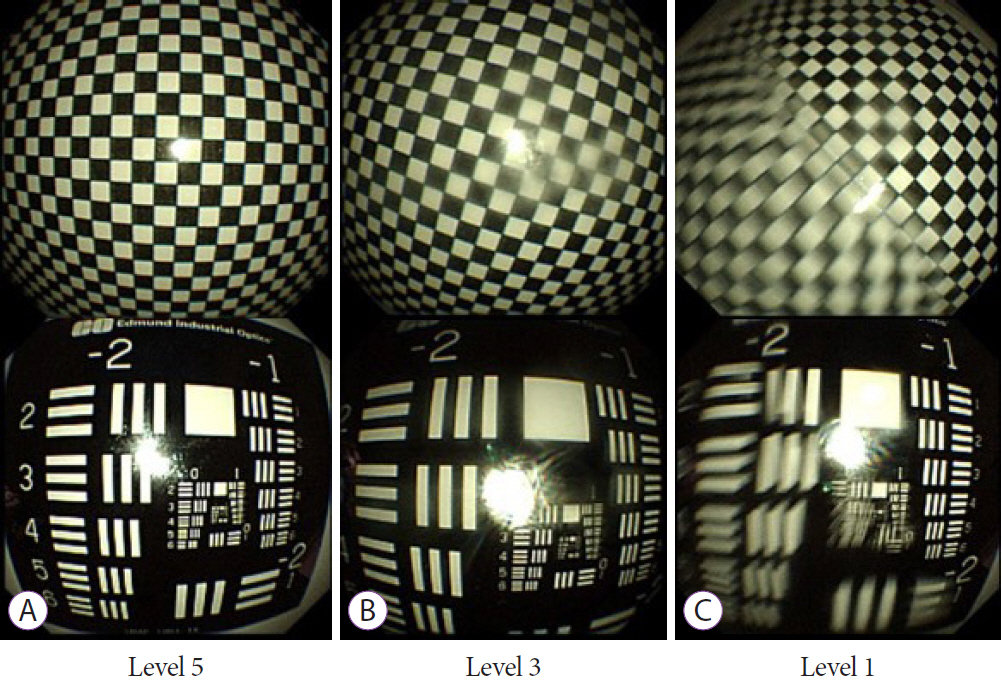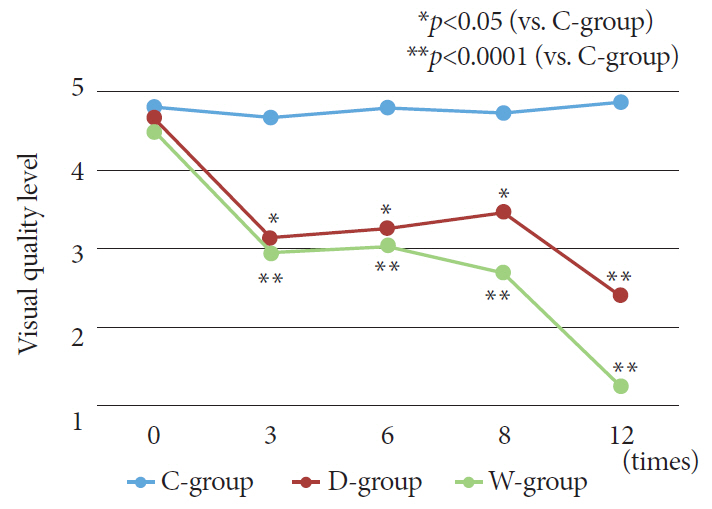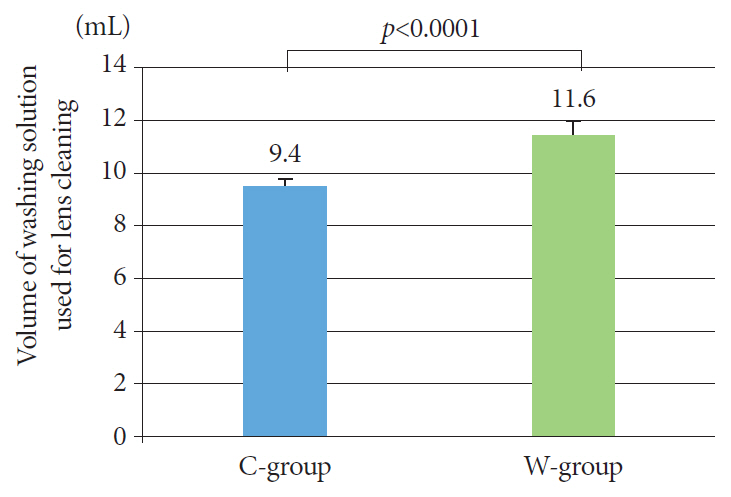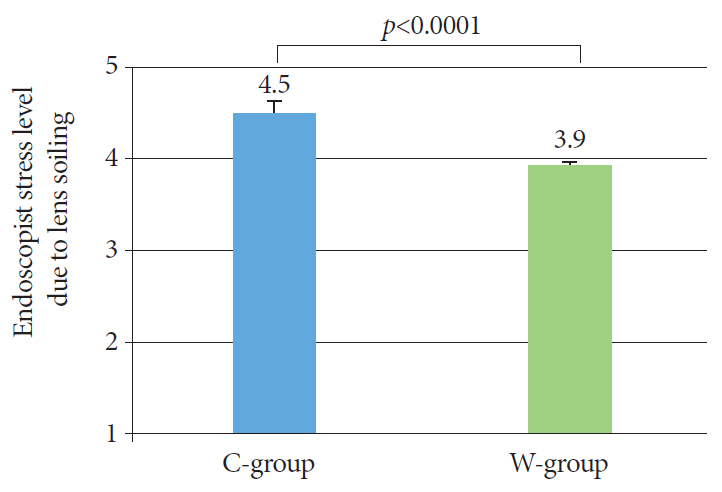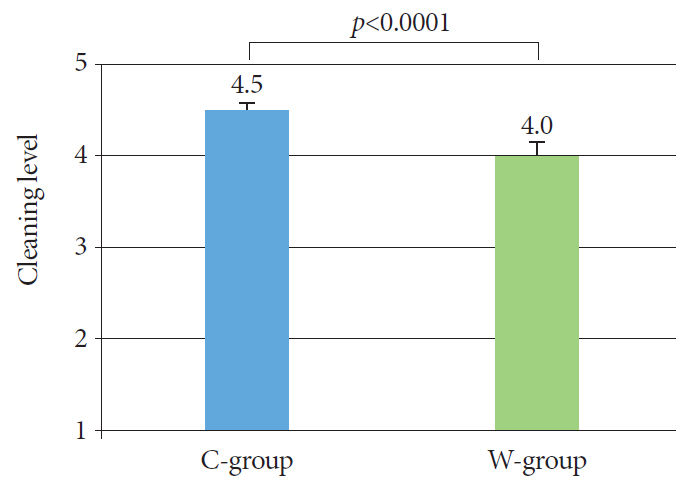Clin Endosc.
2021 Mar;54(2):236-241. 10.5946/ce.2020.062.
Effectiveness of Solution with 5% Detergent for Cleaning Transnasal Esophagogastroduodenoscopy Lens
- Affiliations
-
- 1Department of Gastroenterology, Izumo Tokushukai Hospital, Izumo, Japan
- 2Division of Internal Medicine, Izumo City General Medical Center, Izumo, Japan
- KMID: 2514178
- DOI: http://doi.org/10.5946/ce.2020.062
Abstract
- Background/Aims
Unsedated transnasal esophagogastroduodenoscopy (EGD) is affected by a poor scope lens-cleaning function. We have previously reported good, albeit limited, effects of an oolong tea washing solution; here, we evaluated the effectiveness of a 5% lens cleaning solution for cleaning an EGD lens.
Methods
Five percent lens cleaning solution (C), 5% dimethicone solution (D), and distilled water (W) were prepared. Study I: Lenses were soiled with pork grease, washed with each washing solution, and their image quality was judged. Study II: Patients (n=996) scheduled for transnasal EGD were randomly assigned to the C- or W-group. Lens cleanliness level, washing solution volume used, and endoscopist stress due to lens contamination were determined.
Results
Study I: The image quality of the lenses washed with (C) was significantly superior. (D) was clinically unsuitable because of spray nozzle clogging. Study II: Lens cleaning in the C-group was significantly superior (p<0.0001) and the solution volume required was significantly reduced (p<0.0001), while endoscopist stress was also lower (p<0.0001).
Conclusions
For transnasal small-caliber EGD, the present 5% lens cleaning solution provided good visibility. It features a high detergency level and is simple to formulate for therapeutic endoscopy applications, such as endoscopic submucosal dissection.
Keyword
Figure
Reference
-
1. Yuki M, Amano Y, Komazawa Y, et al. Unsedated transnasal small-caliber esophagogastroduodenoscopy in elderly and bedridden patients. World J Gastroenterol. 2009; 15:5586–5591.
Article2. Yagi J, Adachi K, Arima N, et al. A prospective randomized comparative study on the safety and tolerability of transnasal esophagogastroduodenoscopy. Endoscopy. 2005; 37:1226–1231.
Article3. Kawai T, Miyazaki I, Yagi K, et al. Comparison of the effects on cardiopulmonary function of ultrathin transnasal versus normal diameter transoral esophagogastroduodenoscopy in Japan. Hepatogastroenterology. 2007; 54:770–774.4. Kobayashi Y, Komazawa Y, Yuki M, et al. Use of anticoagulant or antiplatelet agents is not related to epistaxis in patients undergoing transnasal endoscopy. Endosc Int Open. 2018; 6:E104–E110.
Article5. Stroppa I, Grasso E, Paoluzi OA, et al. Unsedated transnasal versus transoral sedated upper gastrointestinal endoscopy: a one-series prospective study on safety and patient acceptability. Dig Liver Dis. 2008; 40:767–775.
Article6. Ai ZL, Lan CH, Fan LL, et al. Unsedated transnasal upper gastrointestinal endoscopy has favorable diagnostic effectiveness, cardiopulmonary safety, and patient satisfaction compared with conventional or sedated endoscopy. Surg Endosc. 2012; 26:3565–3572.
Article7. Komazawa Y, Amano Y, Yuki M, et al. Oolong tea is useful for lens cleansing in transnasal small-caliber esophagogastroduodenoscopy. Endoscopy. 2010; 42:104–108.
Article8. Tanuma T, Morita Y, Doyama H. Current status of transnasal endoscopy worldwide using ultrathin videoscope for upper gastrointestinal tract. Dig Endosc. 2016; 28(Suppl 1):25–31.
Article9. Hayashi Y, Yamamoto Y, Suganuma T, et al. Comparison of the diagnostic utility of the ultrathin endoscope and the conventional endoscope in early gastric cancer screening. Dig Endosc. 2009; 21:116–121.
Article10. Horiuchi A, Nakayama Y, Hidaka N, Ichise Y, Kajiyama M, Tanaka N. Prospective comparison between sedated high-definition oral and unsedated ultrathin transnasal esophagogastroduodenoscopy in the same subjects: pilot study. Dig Endosc. 2009; 21:24–28.
Article11. Yoshida N, Naito Y, Hirose R, et al. Risk of lens cloudiness during colorectal endoscopic submucosal dissection and ability of a novel lens cleaner to maintain and restore endoscopic view. Dig Endosc. 2015; 27:609–617.
Article12. Yoshida N, Naito Y, Yasuda R, et al. A novel lens cleaner to prevent water drop adhesions during colonoscopy and esophagogastroduodenoscopy. Endosc Int Open. 2017; 5:E1235–E1241.
Article13. Song S, Zhu L, Zhou W. Simultaneous removal of phenanthrene and cadmium from contaminated soils by saponin, a plant-derived biosurfactant. Environ Pollut. 2008; 156:1368–1370.
Article14. Tatsumi Y, Harada A, Matsumoto T, Tani T, Nishida H. Current status and evaluation of transnasal esophagogastroduodenoscopy. Dig Endosc. 2009; 21:141–146.
Article15. Saito Y, Uraoka T, Yamaguchi Y, et al. A prospective, multicenter study of 1111 colorectal endoscopic submucosal dissections (with video). Gastrointest Endosc. 2010; 72:1217–1225.
Article
- Full Text Links
- Actions
-
Cited
- CITED
-
- Close
- Share
- Similar articles
-
- Comparison of Equipment Contamination Level according to Enteral Nutrition Bag Cleaning and Disinfection Methods
- Proper Management for Rigid Gas Permeable Contact and Orthokeratology Lens
- Detergent Solution-induced Alkaline Burn of Hand: A Case Report and Review of Literature
- Outbreak of Cystoscopy-Related Urinary Tract Infections With Pseudomonas aeruginosa in South Korea, 2022: A Case Series
- Antimycobacterial Activities of Dodecyl diaminoethyl glycin hydrolchloride as a Disinfectant

